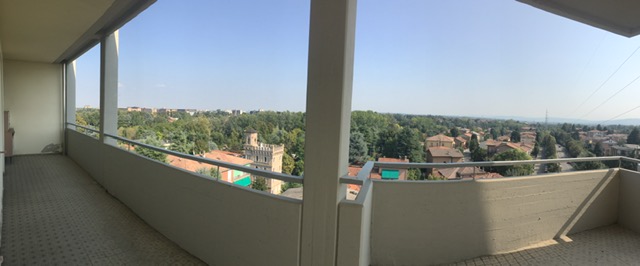The Roman Empire, with its decline, left large power vacuums in Europe. The different populations, once subjugated by the Romans, mingled with other peoples from the Eastern Colonies. Christianity aimed to unify all those new People. The Early Middle Ages, which began around 600 A.D. and lasted nearly 400 years, saw an impoverished Europe, dominated by Barbarians and primitive types of Fiefs. The houses were generally born around fortified Castles and Monasteries run by Ecclesiastical Orders. The Early Middle Ages, began around 1000 AD and ended in 1400 AD, coinciding with a new ferment, the birth of new Cities, the restocking and flowering of commerce, craftmanship and agriculture. The Cities were presided over by prominent Families, sometimes independent from the Papacy and the Empire; they were usually orthogonal or radiocentric shaped, with radial streets converging towards a central square; streets were of different sizes and, generally, irregular. Their main buildings were the Town Hall, overlooking the main square, and the Castle, usually located on the exterior Walls. In these Cities there were also many Religious Buildings: from the Cathedrals, with their very tall steeples (the most important places of religious power), to the Convents of the “beggars” orders (Franciscan and Dominican) with their Churches, up to the Monasteries, external and isolated, belonging to the orders Benedictine, Cistercian and Carthusian. The fortified City of the Early Middle Ages is the Hamlet, surrounded by Walls and Moats, Towers, Battlements and Walkways, to defend it from the enemy sieges. Then, the increasing population, coming from the countryside, that had accumulated around the Hamlet Walls, formed the so-called outskirts, which grew fast and had to be included into further Walls, then other Walls were subsequently further on added to them. The City was dependent on agriculture, for the food and the raw materials, which were then transformed, with the subsequent exportation of handicraft products through dealers. The new urban classes, merchants and artisans, increased in heir exponents number, and began to reach more influence, colliding with the power of the Feudal Lords and Papal Bishops ; these new social groups took power and created a new form of public association: the Municipality, which both the Feudal Power and the Religious Power had to accept . Meanwhile, the distance between employees and agricultural workers, and the new citizens of the wealthy classes was running up, excluding the first ones from the public and political City life. The revolts of these classes sanctioned the end of the Municipality, with the seizure of power by important and generous Noble Families . Aftreward it came the period of the powerful Lords, where the Cities, despite the subjection to the Lords of the Courts, had anyway an autonomous Government, lead by an elected Magistrate, to guarantee the independence and freedom to their citizens. The Medieval City, unlike the Roman City, didn’t make big distinctions between public and private, and the houses were contiguous, stacked, multi-storey and overlooked the public spaces. The houses were stone and brick made, to prevent fires, unfortunately already well known by people. The houses of the merchant and artisan classes were often single-family and indipendent. Along the streets the houses of craftsmen belonging to the same guild (Shoemakers, blacksmiths, etc …)were grouped. These homes were often rented by rich families, which were the owners. In the ground floor there was either warehouse of the merchant or the laboratory of the artisan, sometimes attached to the small back yard (where they grew vegetables and herbs and where the garbage was given to the poultry ), at the first floor there were the kitchen and living room, at the second floor there were the bedrooms, where the people often slept in groups, and where, sometimes, also maids and servants rested . The houses of the wealthy resembled the Roman Domuses, with inner courtyards, however, compared to them, there had been an involution: in fact the water didnn’t come in through the aqueduct and came out through the drain, but, it was taken from the well, or from the fountains, and directly discharged over the streets. The wealthier citizens also built some extremely tall towers, that had to express their importance . In the Cities were located many buildings of different shapes and heights, that represented the new trend of individualism, typical of the bourgeoisie. The streets were often unpaved, and full of craftsmen who worked, of women who washed their clothes, of children who played and of people who walked. Cleaning was not sovereign in the Medieval City and with the increasing population and urbanization very bad pestilences gradually arose. The Medieval Italian House is, therefore, a single-family house, a house and shop together, built of brick, and sometimes with parts of wood. Takes light from the street and generally has a narrow frontage on it, not exceeding five meters; the windows are small and few; the balconies and the roof terraces, wooden, and often numerous. Because of the rapid increase in urban population, the City was filling with houses anywhere. The houses were stacked and joined together. In every corner of the City and in every street there are arches and vaults where new homes are located. The houses, which followed one another, often had arched porticos, especially the most important ones, on the foreheads. They also had different heights, to arrive at a maximum of two or three floors. Under the arcades, often, merchants and artisans exposed their products, encroaching sometings up to the road.
|
|||||
The Medieval House |
|||||
|
Copyright © 2025 Peter Houses - All Rights Reserved Powered by WordPress & Atahualpa |
|||||





